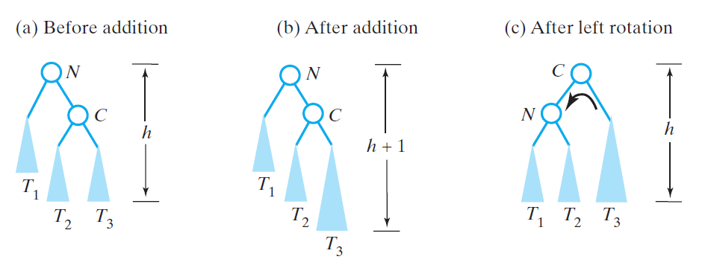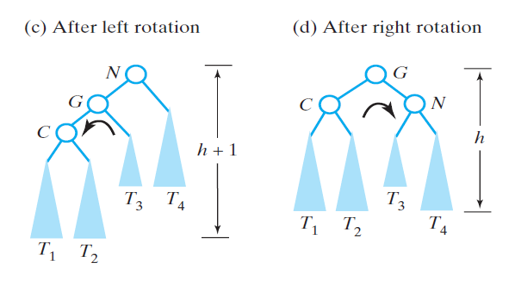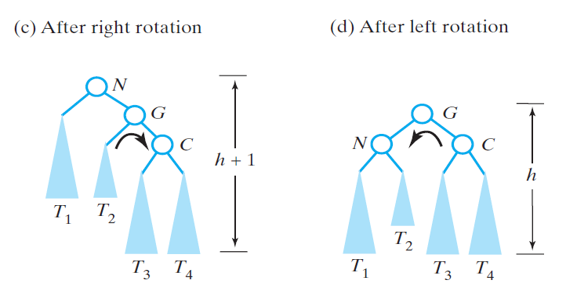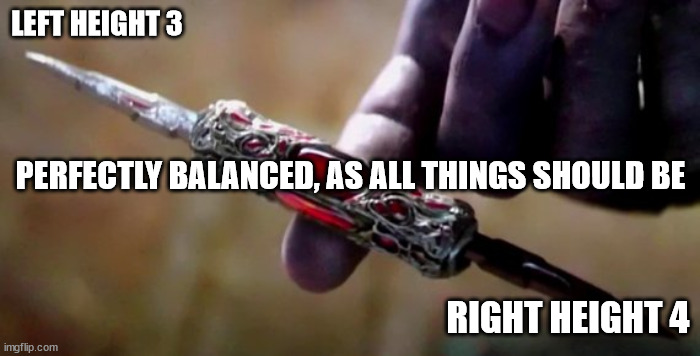AVL Trees
CSC 385 - Data Structures and Algorithms
Brian-Thomas Rogers
University of Illinois Springfield
College of Health, Science, and Technology
Objectives
Objectives
- Know what balance means in the context of binary search trees
- Understand the balancing rules for an AVL Trees
- Know the algorithms for performing the four different rotations
- Know that the worst-case running times for an unbalanced tree are \(O(n)\) but \(O(log n)\) for a properly balanced tree
AVL Tree Basics
AVL Tree Basics
- Created by Adelson-Velsky and Landis
- AVL Trees are balanced Binary Search Trees using the following property
- For any given node in an AVL tree, the heights of the node’s left and right subtrees may differ by at most 1
- If the ballance of a binary tree is lost after adding or removing items the AVL Tree rearranges the nodes by rotation to keep maintain balance
Rotations
Imbalance Cases
- There are 4 cases when a node X becomes imbalanced
- Case 1: Imbalance is in the left subtree of X’s left child
- Case 2: Imbalance is in the right subtree of X’s right child
- Case 3: Imbalance is in the right subtree of X’s left child
- Case 4: Imbalance is in the left subtree of X’s right child
Imbalance Case 1

The imbalance is fixed with a right rotation
- Algorithm for right rotation about N
- C = N.left
- N.left = C.right
- C.right = N
Imbalance Case 1 Initial Tree
Imbalance Case 1 Rotation
- Add node 1 to the tree
- The imbalance is detected by the root node 10
- Left subtree height is 4 while right subtree height is 2
- The imbalance is in 10’s left child’s left subtree.
- A right rotation happens about the root
Imbalance Case 1 After Rotation
- Height of both left and right subtrees are now 3
- The tree is balanced
Imbalance Case 2

The fix for this case is by using a left rotation
- Algorithm for left rotation about node N
- C = N.right
- N.right = C.left
- C.left = N
Imbalance Case 2 Initial Tree
Imbalance Case 2 Rotation
- Add node 40 to the tree
- The imbalance is detected by the root node 10
- Left subtree has height 2 while right subtree has height 4
- The imbalance is in 10’s right child’s right subtree
- A left rotation happens about the root
Imbalance Case 2 After Rotation
- The height of the left and right subtree at the root is 3.
Imbalance Case 3
- The imbalance of case 3 is fixed by doing double rotations
- First, perform a left rotation on the imbalanced child
- Then, perform a right rotation on the parent


Imbalance Case 3 Initial Tree
Imbalance Case 3 First Rotation
- Tree becomes imbalanced when 10 is added
- Imbalance occurs in 12’s left child’s right subtree
- Left Rotation occurs on the left child first
- Result on next slide
Imbalance Case 3 Second Rotation
- Tree is still imbalanced so we do a right rotation about 12 now
Imbalance Case 3 After Rotations
- After the last rotation the tree becomes balanced
Imbalance Case 4
- The imbalance of case 4 is fixed by doing double rotations
- First, perform a right rotation on the imbalanced child
- Then, perform a left rotation on the parent


Imbalance Case 4 Initial Tree
Imbalance Case 4 Right Rotation
- Tree imbalanced after adding 18
- Perform right rotation about 20
- Result on next page
Imbalance Case 4 Left Rotation
- Tree is stil imbalanced so now we do a left rotation
Imbalance Case 4 After Rotations
- Tree is balanced after performing both rotations
Notes
- The examples have the rotation in the root of the tree but this is not always the case
- Here is an example where a rotation happens but not on root
- Here, the imbalance occurs in 20’s right child’s right subtree after adding 40
- This requires a left rotation about 20
- Root will then have a balance of left height 1, right height 2 after the rotation
AVL Tree Implementation
AVL Tree Implementation
- Similar to the binary search tree with the following additions
- The TreeNode class now has additional properties to keep track of the height of the subtrees
- There are 2 additional methods for the rotations, a method to rebalance, and utility methods to fix the height of a node and a method to calculate the balance of a subtree
- The add and remove must include the balance correction mechanism
- The add and remove becomes a two-pass algorithm
- First pass either adds or removes a node by traversing down the tree
- Second pass corrects imbalances by backtracking the path taken and fixing the height property of each node and correcting any imbalances that occur
Practice Questions
Question 1
- What rotation/rotations need to be performed on the following tree after John is added?
Answer 1
- Working backwards from John we see Ellie is balanced with left height 0 and right height 1 but Tania is imbalanced with left height 2 and right height 0.
- Where does the imbalance occur?
- Tania’s left child’s right subtree
- This is case 3 so a left rotation then right rotation
Perform Left Rotation about Ellie
Rotate right about Tania
Answer 1 Complete
Practice Question 2
- What rotation/rotations need to be performed to balance the following Tree after adding Nat?
Answer 2
- Working backwards from Nat we see that Matt is balanced, Oscar is balanced, but Frank is not
- Where does the imbalance occur?
- Frank’s right child’s left subtree
- This is case 4 so a right rotation and then a left rotation
Perform Left Rotation about Oscar
Rotate right about Frank
Answer 2 Complete
End


CSC 385 - Data Structures and Algorithms